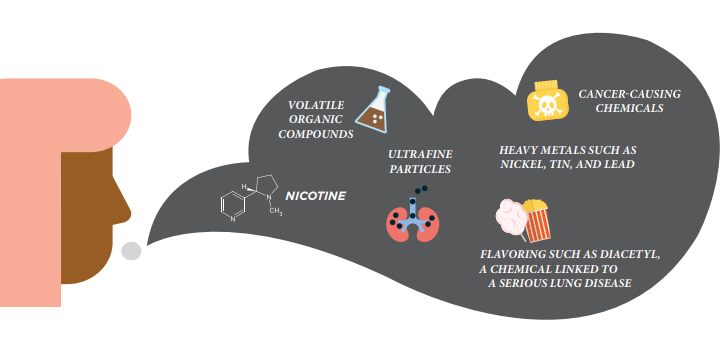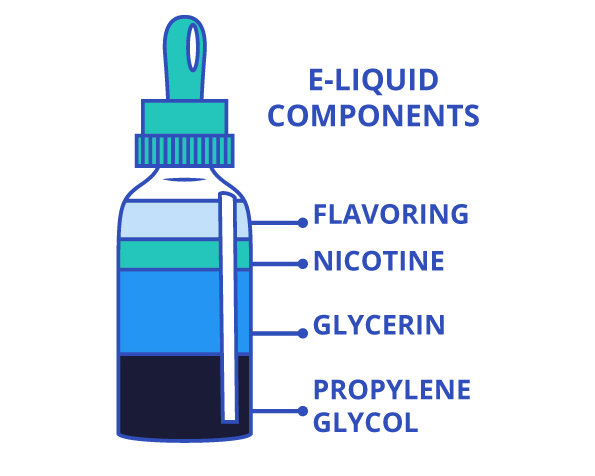Most e-liquids for e-cigarettes contain 0% to 10% water to aid vaporization and adjust viscosity.
Introduction to E-cigarettes
E-cigarettes, also known as electronic cigarettes, have surged in popularity over the last decade. They offer an alternative to traditional tobacco smoking, using a battery-powered device to heat a liquid into a vapor that the user inhales. This process is often referred to as “vaping.” The appeal of e-cigarettes lies in their ability to simulate smoking without burning tobacco, potentially reducing the exposure to some harmful chemicals.
Overview of E-cigarettes
E-cigarettes come in various shapes and sizes, ranging from those that look like traditional cigarettes to pen-like devices and large, boxy configurations. The diversity in design caters to a wide array of preferences and vaping habits. As of 2023, the market has expanded to include models with adjustable settings for temperature and voltage, enhancing the user experience by allowing for customization of vapor production and flavor intensity.
The primary allure of e-cigarettes lies in their claim to offer a less harmful alternative to conventional smoking. Supporters argue that by avoiding combustion, e-cigarettes significantly reduce the user’s exposure to carcinogens and other toxic substances found in tobacco smoke. Critics, however, caution about the potential health risks associated with inhaling vaporized chemicals, including nicotine, which remains a highly addictive substance.
Components of E-cigarettes
The basic components of e-cigarettes include a battery, an atomizer, and a cartridge or tank. The battery is the device’s power source, typically rechargeable, and varies in capacity and lifespan. High-end models might offer batteries with a capacity of up to 3000mAh, providing extended use times before needing a recharge. The atomizer, equipped with a heating element, vaporizes the liquid, which typically consists of nicotine, flavorings, and a base of propylene glycol (PG) or vegetable glycerin (VG).
The cartridge or tank holds the e-liquid and is either refillable or disposable. Refillable models offer more flexibility in e-liquid choice and can be more cost-effective in the long run. For instance, a 30ml bottle of e-liquid might cost around $20 and can last for several weeks, depending on usage patterns, whereas disposable cartridges may offer less value over time.
The role of water in e-liquids is to dilute the solution and assist in the vaporization process. Though water content varies, it typically does not exceed 10% of the e-liquid’s composition. The balance between PG and VG significantly influences the texture and volume of the vapor produced, with VG leading to denser clouds and PG offering a stronger throat hit, mimicking the sensation of smoking tobacco.
In exploring the evolution and components of e-cigarettes, it becomes clear that technological advancements and a focus on customization have defined the industry’s growth. With ongoing debates about their safety and regulatory challenges, e-cigarettes remain at the forefront of discussions about alternatives to traditional tobacco products. Links to further reading on the topic can provide more in-depth insights, such as the Wikipedia entry on E-cigarettes.

Composition of E-cigarette Liquid
The liquid used in e-cigarettes, commonly referred to as e-liquid or vape juice, is the material converted into vapor during the vaping process. This liquid is pivotal in defining the overall vaping experience, influencing everything from flavor to the amount of vapor produced.
Main Ingredients
E-liquid comprises a base, typically a combination of propylene glycol (PG) and vegetable glycerin (VG), nicotine, and flavorings. Propylene glycol is known for its ability to carry flavors and for the throat hit it provides, closely mimicking the sensation of smoking tobacco. Vegetable glycerin is a thicker substance that produces more vapor and gives a sweeter taste to the e-liquid. The ratio of PG to VG significantly affects the vaping experience; for instance, a 70% VG to 30% PG blend is popular among those who prefer large vapor clouds and a smoother hit.
Nicotine content in e-liquids can vary widely, from 0 mg up to 36 mg per milliliter or even higher in some cases. This variability allows users to choose a nicotine strength that matches their preference, whether they are looking for a strong hit similar to traditional cigarettes or prefer a nicotine-free option.
Flavorings in e-liquids are what make vaping a highly customizable experience, with flavors ranging from traditional tobacco and menthol to fruit, dessert, and even beverage-themed options. The quality and composition of flavorings can greatly impact the taste and safety of the vapor.
The Role of Water in E-liquids
Water plays a crucial but often understated role in e-liquids. While not a primary ingredient, water is sometimes added to adjust the viscosity of the e-liquid, especially in high VG blends. Given that vegetable glycerin is quite thick, a small amount of water (usually no more than 5-10% of the total volume) can be added to make the liquid easier to vaporize and to prevent device malfunction.
The precise amount of water in an e-liquid formulation is carefully calibrated to balance the need for efficient vaporization with the desire to maintain the integrity of flavors and the production of vapor. Too much water can lead to a diluted taste and less satisfying vapor, while too little may result in a liquid that is too thick to be effectively used in some e-cigarette models, particularly those with smaller or less powerful atomizers.
Manufacturers and users alike must consider these factors when selecting or creating e-liquid blends, as the balance of ingredients directly impacts the vaping experience. The choice of materials, including the base liquids, nicotine, flavorings, and even the addition of water, defines the quality and performance of the e-liquid.
The Science Behind E-cigarette Vapor
Understanding the science behind e-cigarette vapor is crucial to comprehending how these devices offer an alternative to traditional smoking. The process involves heating a liquid to generate vapor, which is then inhaled by the user.
How E-cigarettes Work
E-cigarettes operate on a simple yet effective mechanism that converts liquid into vapor without the need for combustion. The core components of an e-cigarette include a battery, an atomizer (or coil), and a tank that holds the e-liquid. When the device is activated, either by a button or through inhalation depending on the design, the battery powers the atomizer. The atomizer then heats the e-liquid, causing it to vaporize.
The efficiency of this process depends greatly on the power output of the battery, which is measured in watts. Modern e-cigarettes offer variable wattage settings, allowing users to adjust the temperature of the atomizer coil. This customization can enhance the vaping experience by altering the density and flavor intensity of the vapor. For instance, devices with a power output ranging from 10 to over 200 watts cater to a broad spectrum of user preferences, from those who enjoy a mild flavor and vapor production to those seeking intense flavors and large vapor clouds.
Vaporization Process
The vaporization process in e-cigarettes is a result of the careful design and engineering of the atomizer and the e-liquid’s composition. The atomizer heats the e-liquid to a temperature between 100-250°C, turning it into an aerosol that can be inhaled. This temperature range is critical; it is high enough to vaporize the liquid but low enough to avoid the combustion of materials, which can produce harmful by-products.
The effectiveness of the vaporization process is influenced by the ratio of propylene glycol (PG) to vegetable glycerin (VG) in the e-liquid. PG is thinner and has a lower vaporization temperature compared to VG, which is thicker and requires more heat to vaporize. E-liquids with a higher VG content typically need more powerful batteries or atomizers to achieve the desired vaporization efficiency.
The role of water in e-liquids also comes into play during vaporization. Adding a small amount of water can help to lower the viscosity of the e-liquid, making it easier to vaporize, especially in e-liquids with a high VG content. This adjustment ensures that the vaporization process is smooth and efficient, contributing to a satisfactory vaping experience.
The science behind e-cigarette vapor illustrates the complex interplay between technology and chemistry that makes vaping possible. By carefully balancing the device’s power, the e-liquid’s composition, and the atomizer’s design, manufacturers can offer a wide range of vaping experiences to meet the diverse preferences of users.

Water Content in E-cigarettes
The water content in e-cigarettes plays a significant role in the vaping experience, affecting everything from the vapor production to the intensity of the flavor. Understanding the typical range of water content and the factors that influence it can help users and manufacturers optimize e-liquid formulations for the best possible experience.
Typical Water Content Range
E-liquids are primarily composed of propylene glycol (PG), vegetable glycerin (VG), nicotine, flavorings, and water. The water content in e-liquids typically ranges from 0% to 10%. This range is carefully considered to ensure that the e-liquid can be efficiently vaporized while maintaining the desired consistency and flavor profile. E-liquids with higher water content may vaporize more easily, reducing the strain on the e-cigarette’s atomizer and battery. However, too much water can dilute the flavor and reduce the viscosity of the e-liquid, which might lead to leaking from the tank.
Factors Affecting Water Content
Several factors influence the water content in e-liquids, with the PG/VG ratio being one of the most significant. PG is less viscous than VG and more easily absorbs water. E-liquids with a higher PG content can thus incorporate more water without adversely affecting the vaping experience. Conversely, VG is thicker and requires less water to achieve the desired viscosity. E-liquids designed for larger vapor production, which typically have a higher VG content, may have lower overall water content to maintain a thick consistency that produces dense vapor clouds.
The desired vapor production and device compatibility also play crucial roles in determining water content. Devices with lower power output may perform better with e-liquids that have a slightly higher water content, as the thinner liquid can be vaporized more easily at lower temperatures. In contrast, high-powered devices can effectively vaporize thicker e-liquids with less water.
Manufacturers must balance these factors to produce e-liquids that offer the optimal vaping experience for their intended device and target audience. The selection of water content is a critical aspect of e-liquid formulation that impacts the performance and enjoyment of e-cigarettes. As the industry continues to evolve, ongoing research and innovation in e-liquid composition will likely provide users with an even wider range of vaping options.